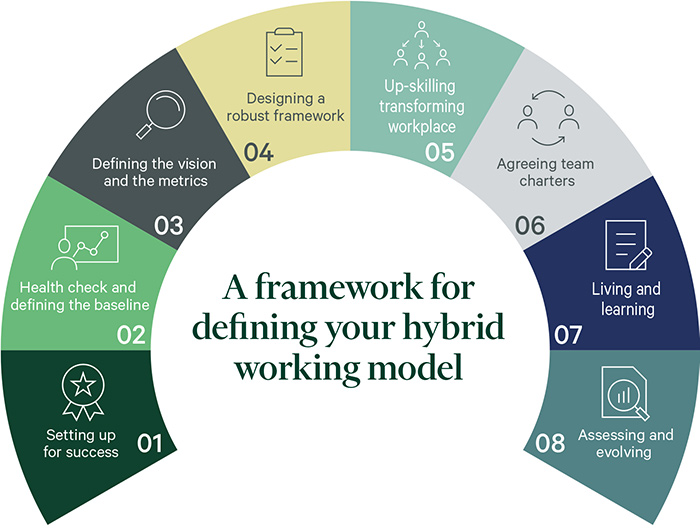Make Hybrid Work:
A Framework For The Ultimate Hybrid Working Model
Fundamentally, there must be a “why” for hybrid working
 By Kate Smith, CBRE’s Executive Director, Occupier Consulting and James Fisher, CBRE’s Sales Director, Facilities Management.
By Kate Smith, CBRE’s Executive Director, Occupier Consulting and James Fisher, CBRE’s Sales Director, Facilities Management.
Organisations in every office-based industry are still grappling to uncover the definitive solution for hybrid working and optimum workplace occupancy levels. But why do companies want remote workers to Return to Office (RTO)?
The reasons are influenced by a mix of drivers, including:
- A need to optimise real estate and facilities management (FM) expenditure
- To improve collaboration, productivity and team building
- To reinvigorate company culture and living company values
- To support the development of young talent and the natural mentorship from senior colleagues
- To optimise the experience for those working in the office (i.e. an empty office diminishes the employee experience for those who attend regularly)
What Is A Hybrid Working Model?
A hybrid working model is the approach that a company adopts to enable team members to work from a flexible mix of locations. Team members can work from home, remotely, from a client site or a company's offices. A hybrid working model should be aligned with the company's culture, vision and values. There are three main types of hybrid working models:
- Office-first: Believes office attendance most of the time is critical to company culture or mode of operation
- Blended: Offers flexibility to work outside the office but expect a balance of time between home and office
- Virtual-first: Accepts that virtual working most of the time works for their business, people and culture
The Great British Commute
Britons have some of the longest commutes in Europe, and the involuntary remote working experiment during the pandemic proved that most organisations could operate effectively without employees traveling into offices. As a result, office workers need more compelling reasons to travel into their place of work.
CBRE’s Client Employee Sentiment Survey showed that people spent an average of 0.8 days per week at home prior to the Covid 19 pandemic. When asked, how many days a week they would now like to work from home or work remotely (in 2022), the answer was 2.8 days a week. This demonstrates an undeniable shift in mindset and preferences towards hybrid working or remote working.
If Businesses Want Employees To Return To The Office,
They Must Give Them A “Why”

Companies now need to "earn the commute" by providing convincing rationale for employees to increase their workplace attendance. At present, occupancy remains low with only 3% of CBRE clients viewing their occupancy levels as optimal (a third of those surveyed said their occupancy is 40% or lower below optimal occupancy).
CBRE has found that many companies are still firmly on the fence when it comes to their plans for the future of work and the perfect hybrid model for their organisation. Companies are struggling to draw conclusions on office occupancy requirements as the relationship between the employee and office is continually evolving. Coupled with challenging market conditions and increases in the cost of living, companies are hesitant to make a call on their long-term occupancy strategy.
The Role Of Facilities In Increasing Workplace Occupancy In A Hybrid Work Model
Whatever the driver, there is no one-size-fits-all solution to increasing occupancy rates.
According to Envoy’s 2022 Workplace Trends Report, the top three areas where companies have increased investment to attract employees back to the office are:
- On-site events and programmes (174% increase)
- Remote collaboration tools (83% increase)
- On-site food and beverages (62% increase)
However, evidence suggests that these investments are not having a sustained influence on office attendance.
Facilities management (FM) teams need to deeply understand the vision, culture, needs and behaviours of the organisation and its people to find the solutions that will work for individual businesses. Other factors, such as office size, location and employee demographic, also play a huge role in what solutions will achieve the desired outcomes.
The key element to making hybrid work is agreeing on why employees should be in the office, only then can the company best strategise on the ‘how’.
“Only when the C-Suite agrees on why employees should be in the office [e.g., collaboration, teamwork, connectivity, culture, compliance, mentorship] can the company best strategise on the ‘how’.” - CBRE Global Workplace Solutions Client
A Framework For Defining Your Hybrid Working Model
Our model sets out eight steps that an organisation can take to ensure the success of hybrid working in their workplace. The key to success involves clear and consistent messaging from leadership and alignment on the roles that functional partners must play. This approach forms part of CBRE’s Making Hybrid Work product which helps clients diagnose the challenges they are facing and provide practical guidance and support across three crucial areas:
- The Workplace Experience that employees have when they visit the office
- The Hybrid Routines in place to support effective hybrid working routines
- The Hybrid Behaviours that are expected from employees and leaders

Tactics For Bringing Employees Back To The Office
After completing the eight-step programme, organisations will have developed a bespoke hybrid working model and deciphered the drivers that will compel employees to return to the office — if that's the best place for them to do the work they need to do. To support this strategy and ensure the success of hybrid working, we have collated examples of how CBRE is supporting its existing clients increase occupancy.
Physical
- Adapt the physical office space to include amenities that support work-life balance, such as on-site gyms, wellbeing spaces, games areas, a creche, dry cleaning, hairdressing and bicycle servicing. This should result in employees feeling supported by the amenities in the office and workers seeing the benefits of going back to the office
- Collaboration, team connection and face-to-face meetings are the primary reasons for visiting the office, so reconfigure the workplace to offer more ‘we space’ than ‘me space’ — team meeting areas, collaboration spaces and adaptable office areas to take priority over rows of desks
- Enhance the workplace’s aesthetics to make it trendy, aspirational and a positive place to spend time in. Hydroponics and internal planting, modern design, reading corners or privacy areas and great coffee can all support this programme of updates and the return of employees to the office
Human
- Double down on improving workplace experience. FM teams can create experience and the feeling of community within an office space, like the feeling of returning to a favourite hotel or restaurant. Being greeted warmly by a friendly face at reception and interacting with a Workplace Host on the office floor can provide a memorable experience and ensure people want to come back. The role of FM teams should not be underestimated when it comes to bringing employees back and sustaining office attendance
- Bolster the events and social calendar to meet the need of workers coming back for social interaction. The key is to highlight the benefits of the office to make colleagues want to come back the office and turn one-off visitors into repeat visitors
- Improve communication systems to ensure remote workers and dispersed colleagues know about the benefits of being in the office. Event previews and news stories can support with enticing people back into the office. Good communication systems can also support increasing occupancy on less busy days (like Mondays and Fridays), by promoting the availability of meeting rooms and desks on these days
- Create a feeling of belonging that is closely linked with the organisation's Diversity, Equity & Inclusion commitments. For example, consider undertaking focus groups with colleagues in diversity networks to understand how the workplace experience and environment could be more inclusive
The Final Word

The effectiveness of the hybrid working framework, and the associated tactics for bringing employees back to the office, relies on companies agreeing on why colleagues should be in the office; only then can the company best strategise on the ‘how’. A clear understanding of what hybrid working is for your business, and consistent guidance on establishing hybrid routines, is essential.
There is no one-size-fits-all solution to increasing occupancy rates – instead, hybrid working must be intricately linked to a company's culture, vision, needs and behaviours. It starts with listening to colleagues and understand their needs.
What we do know is that the workplace must offer some of the benefits colleagues feel when working at home, such as work life balance and focus space, but also something the home cannot. It’s not just about enabling productivity; it’s about creating a community to belong to and offering an experience that you can’t get when working from home.

























































